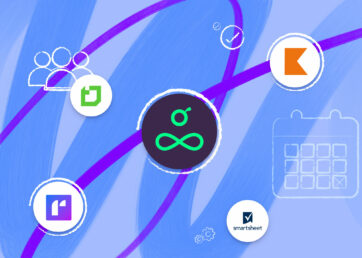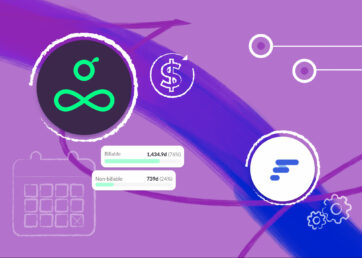Many people talk about project management and resource management software interchangeably. But while there are crossovers in functionality, resource management tools focus on allocating the human resources required for project success, as opposed to purely handling task management.
In this article, we’re taking a look at some of the best resource management tools that can help you plan manageable workloads for your teams and protect the well-being of your most important assets – your employees.
Why you need a tool for resource management
Projects can get complicated fast – even if you’re working on basic tasks with a small team. You need to plan the steps involved for each project, assign the right people for each job, track everyone’s progress from start to finish, and stay within budget. With larger companies, it’s even trickier to reach goals and deadlines if you’re struggling to execute due to resource challenges.
A recent Deloitte survey found that the most significant issues for organizations were the emotional burnout of employees, difficulties in team communication, and the uneven distribution of tasks within or between teams. Your human resources have finite time and energy, so you need to be able to allocate their daily tasks in a way that takes their well-being into account.
With a good resource management tool, you can easily manage skill-based task allocations, resource scheduling, capacity planning, forecasting, time tracking, and leave and vacation requests – plus get actionable insights into productivity and performance.
The tools we’re looking at in this article can either function as a standalone platform for your resource and task management, or be used in conjunction with other project management solutions.
In this article 📖
Best resource management tools in 2024
Resource Guru – Best resource management tool for human resource optimization
If you’re searching for a resource management tool that prioritizes the well-being and productivity of your team members – look no further than Resource Guru.
It’s built specifically to manage the human resources at the heart of every organization – and it’s used by leading brands like Ikea, Ogilvy, and NASA to ensure that teams can complete projects on time while avoiding employee burnout.
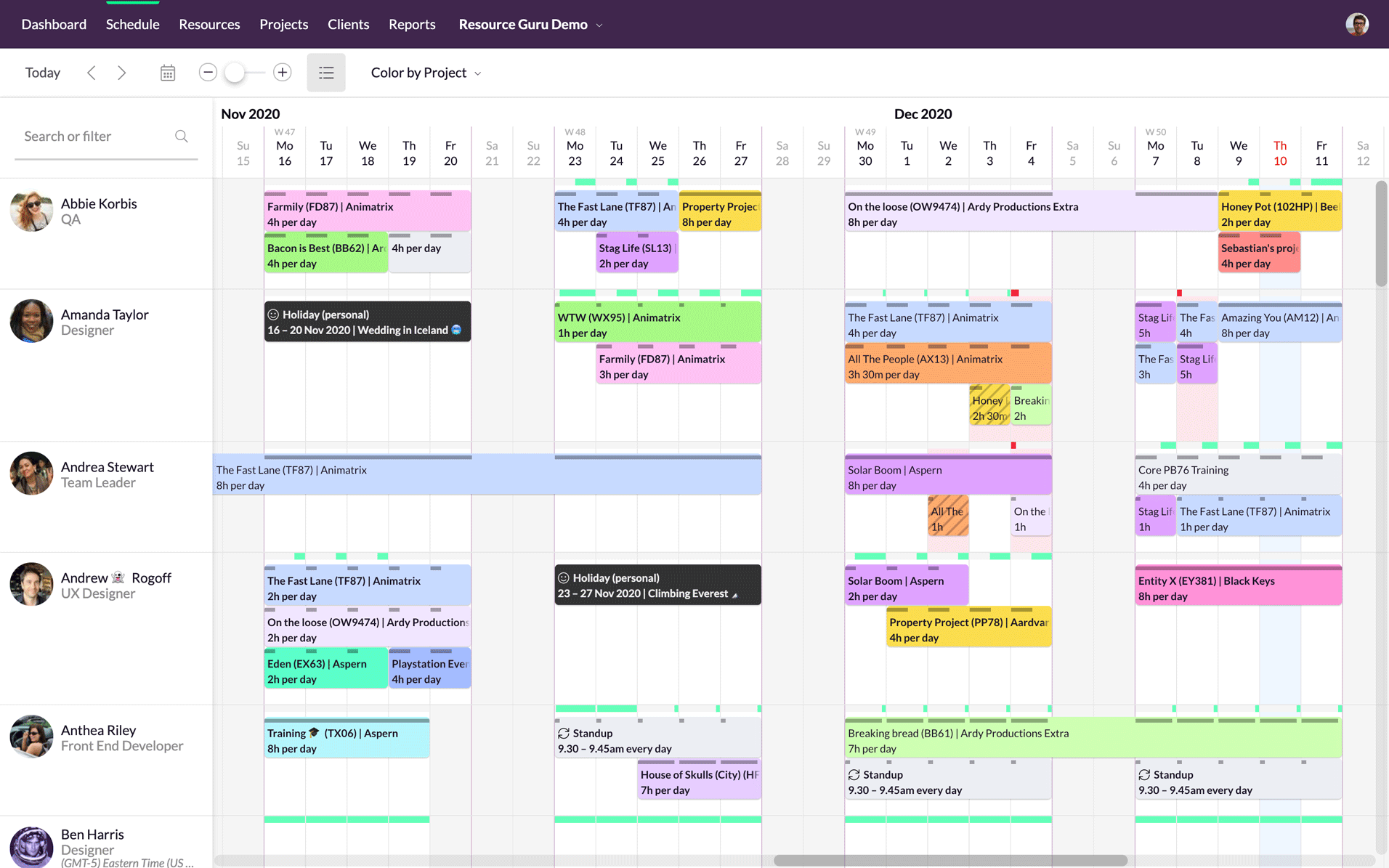
Resource Guru users love the simple UI that offers little to no learning curve, plus the intuitive drag-and-drop interface which makes it easy to use for just about anyone. On the software review site, G2, Resource Guru is rated highest for user satisfaction in the resource management category and earned the #1 spot for Best Usability and Best Results in the G2 2023 Winter Report.
Resource Guru also features a unique clash management system which prevents overbooking of your team members and equipment. This means you can easily assign tasks to the team members who are the best fit, while tracking their availability in real-time and enabling you to easily spot and fix resource conflicts.
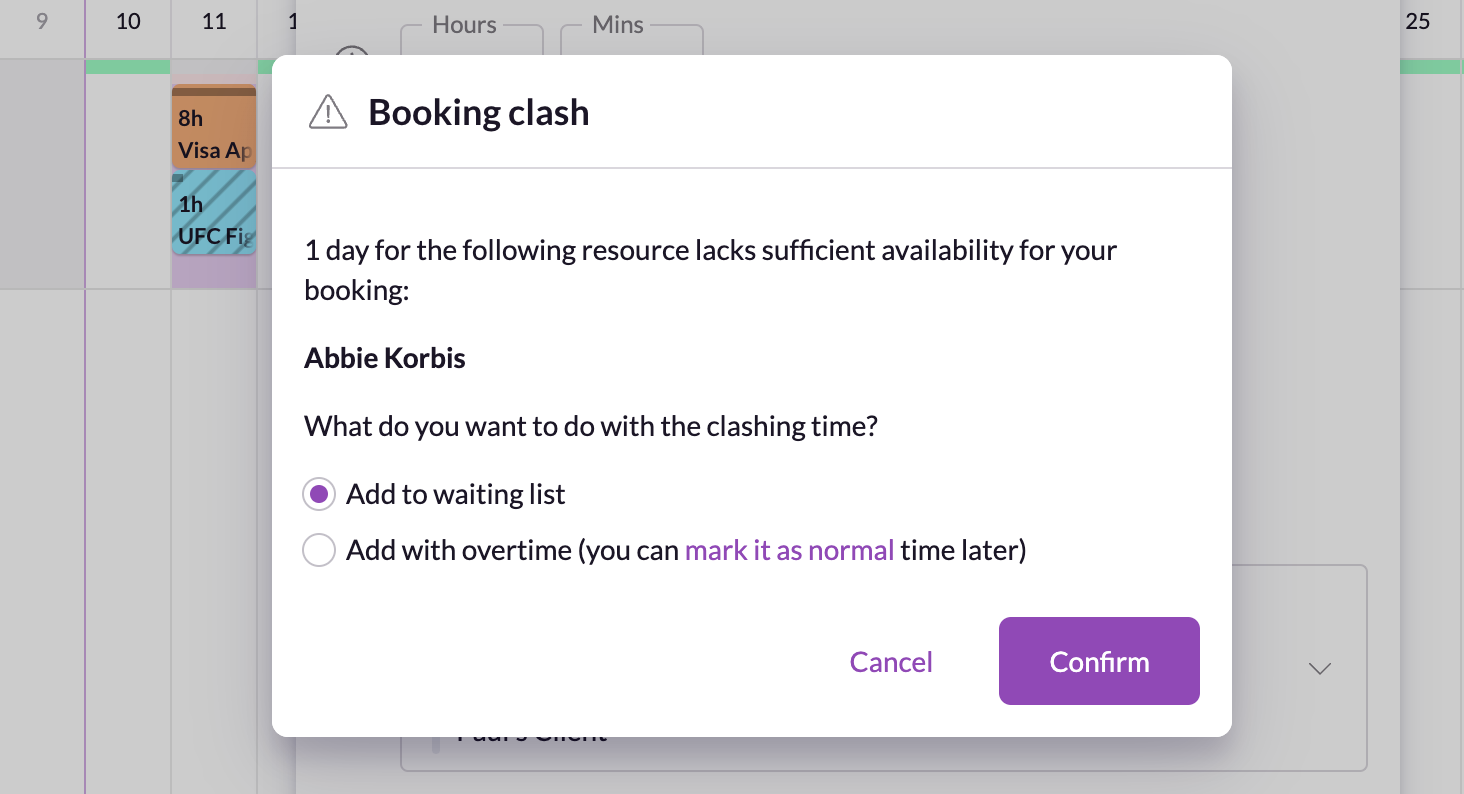
Each team member gets access to their own dashboard in Resource Guru so they can manage their availability and see what’s coming up in their calendar. And with the detailed planning and scheduling features, team members can book their own time off and manage their available hours, no matter how complex their schedules are.
The Availability Bar in the Schedule lets managers see clearly when they can or can’t book someone – and when individuals are overloaded with work or working overtime.
Resource Guru is designed to reduce the risk of project breakdowns due to leave, absences, or overallocation – giving project managers an agile way to optimize their resources and allocate work across projects in a healthy way.
Alongside human resource management, Resource Guru also makes it easy to schedule non-human resources (e.g. equipment and meeting rooms) – bringing together everything you need for each project in one place.
Resource Guru is a robust, standalone tool for resource management – but it also plays nicely with other popular apps (like Outlook Calendar) and project management tools. So if you’re looking to get into the nitty gritty of task management, you may like to use it alongside a more task-oriented tool.
But if you’re mainly looking for a better way to manage your human resources and stay in control of projects and deadlines, Resource Guru offers flexible and unique solutions to help you reach those goals.
Key features
- No learning curve
- Advanced clash management
- Leave management
- Capacity planning
- Track and schedule non-human resources
Pricing
Resource Guru has three straightforward plans:
- Grasshopper (from $4.16 per user, per month)
- Blackbelt (from $6.65 per user, per month)
- Master (from $10 per user, per month)
You can also add on non-human resources for an extra $2-$6 depending on your plan.
Subscriptions can be billed monthly, or you can subscribe to the annual plan and receive two months free – which makes the pricing seriously competitive for this type of resource management tool.
There is also an option for a generous 30-day trial so you can give the platform a good test drive before you sign up.
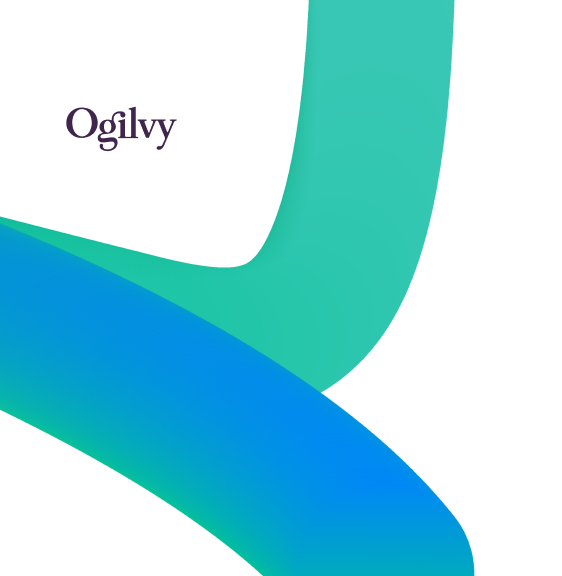

“With the Guru software we get better insights into our daily planning. Great tool & easy to use.”
Forecast – Best all-in-one tool for resource and project management
Forecast positions itself as “the fast and simple way to schedule your team across projects”. It’s designed to help companies increase productivity and performance, and includes features for resource management, task management, forecasting, accounting, and business intelligence.
This means it’s ideal for teams who are looking to manage tasks centrally from start to finish. If you’re looking for a solid resource management tool that covers almost every aspect of project management, Forecast is a good all-in-one option.
Forecast is an affordable, user-friendly resource management solution for business owners and startups (ideally companies with teams of over 50 people) who need a better way to track their scheduling and budget.
Forecast allows me to track resource allocation, the project’s scope, timesheets, expenses and overall progress – all in one place and with an easy-to-understand UI – G2 review
The UI here is modern and intuitive, with user-friendly Kanban boards and list views that make it relatively easy to get set up, plus colorful resource charts. Some customers mention it has a bit of a learning curve – but if you’re used to working in project and time management dashboards, this shouldn’t be a problem.
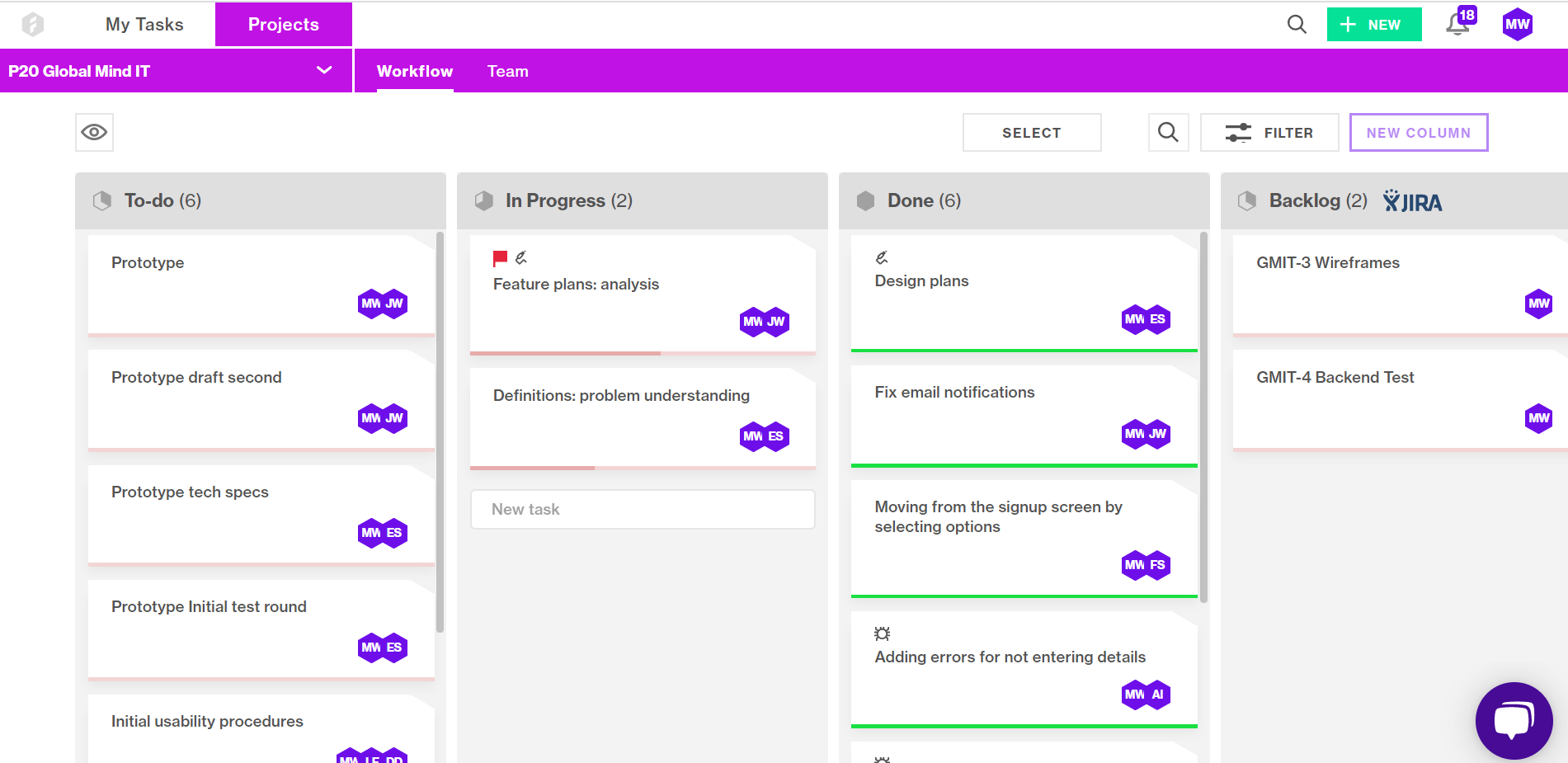
Like Resource Guru, Forecast makes it easy for project managers to get a high-level, real-time overview of people’s capacity and workloads. This helps prevent bottlenecks in projects, and burnouts in team members.
Forecast syncs directly with another tool on our list, Harvest, and it also integrates with 29 other popular apps including Google Drive, Hubspot, Pipedrive, Quickbooks, Jira, and Slack. These integrations can help teams save time and improve on reporting and forecasting – as well as simplifying the resource management side of things.
Key features
- iOS and Android apps
- Turnkey integrations with 30 apps
- Auto scheduler
- Workload planning
Pricing
Forecast offers three standard pricing plans:
- Lite ($29 per seat per month, with a 10-seat minimum)
- Pro ($49 per seat per month, with a 10-seat minimum)
- Plus (custom pricing)
These plans are billed annually, so you’re locked in for 12 months. There’s also a 10-seat minimum, which means you’re paying at least $290 per month (x12). This is almost $3,500 a year – so it’s not ideal for smaller teams or companies on a budget.
Even though there’s a free trial, the downside to Forecast is that there is no free plan. You also can’t use this platform if you have less than 10 people on board, which makes it a no-go for small teams and organizations.
Smartsheet – Best resource management tool for time tracking
Smartsheet positions itself as an all-in-one “modern work management” solution that helps teams to manage projects, automate processes, and scale up to enterprise-grade programs and portfolios. But their strength lies in the platform’s time tracking features.
In the dashboard, you’ll find spreadsheet-style Gantt layouts to help you plan and organize projects in keeping with your organization’s overall goals.
The integrated time tracking and timesheet functions are layered over the Gantt charts to help you to plan and track your projects in real-time, and ensure deadlines can be achieved smoothly. Smartsheet also features mobile time tracking, budget tracking, and expense tracking.
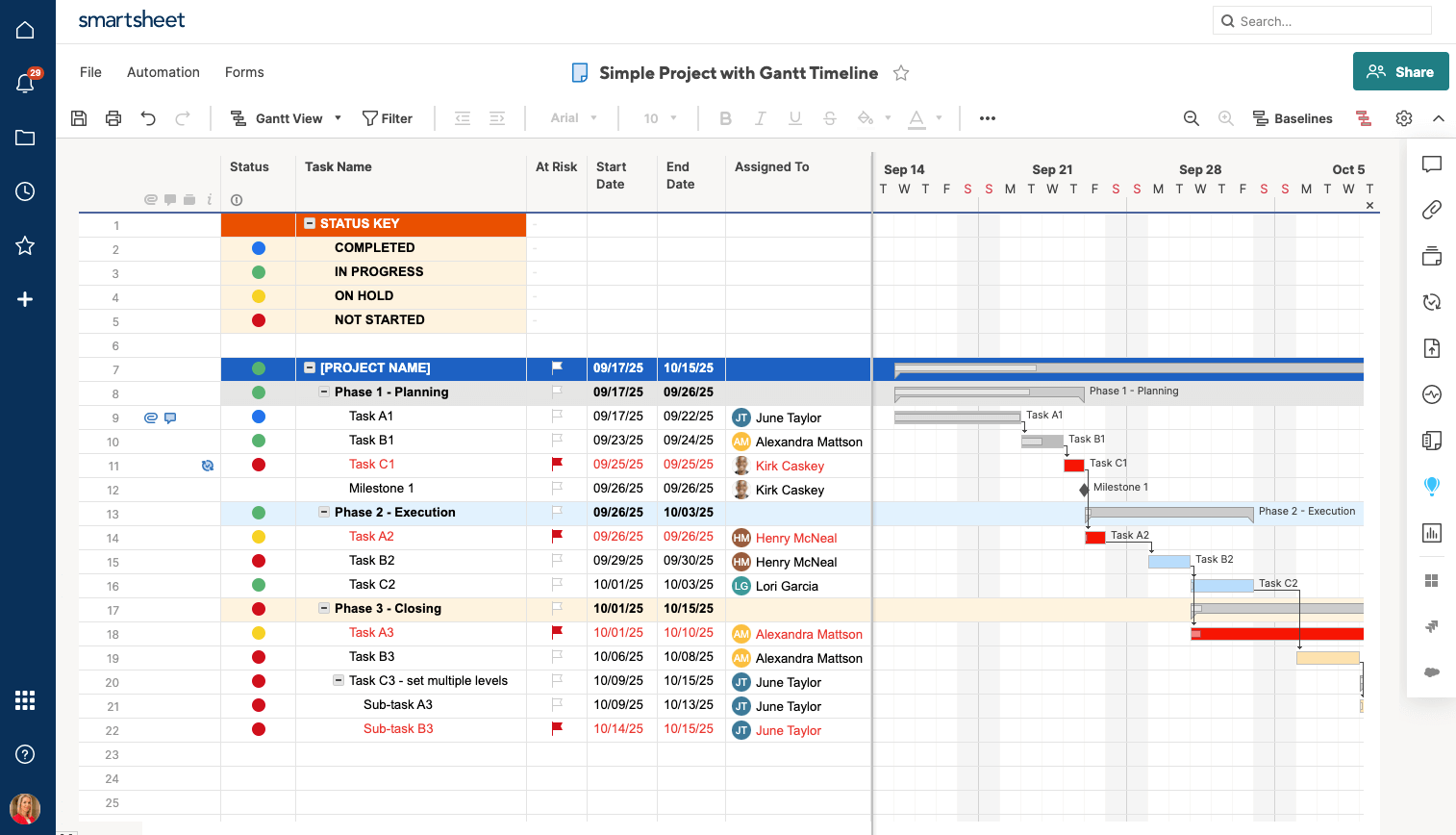
In terms of resource planning, Smartsheet enables project managers to get a complete overview of available resources, quickly find the right resources for tasks, and forecast upcoming workloads. At the team level, members can collaborate easily within the platform to ensure everyone knows who’s doing what at any given time.
Smartsheet offers a good blend of project and resource management capabilities. It integrates with some of the most popular tools in the market, and provides extra flexibility with its Zapier and API integrations. This means you can squeeze even more value out of the platform with detailed analytics, project management tools, enterprise-level resource planning, and accounting functionality.
While it’s technically able to be used by companies of any size, Smartsheet is the best fit for larger organizations that need to manage more complex projects and improve team collaboration and time tracking.
Users report that some features take time to get the hang of, and overall it has a steeper learning curve than other more user-friendly resource management tools like Resource Guru and Float.
Key features
- Time tracking
- Integrated timesheets
- Skills database
- Resource forecasting
Pricing
There are currently three plans available:
- Pro (minimum of 1 user, billed at $9 per user, billed monthly)
- Business (Minimum of 3 users, billed at $32 per user, billed monthly)
- Enterprise (Custom pricing)
Smartsheet has an enterprise focus, so you’ll find the pricing is steeper than other resource management tools out there. For complex team needs, you can also purchase extra add-ons which gives you access to scalable management tools, integrations, and workflow processes.
Teamdeck.io – Best resource management tool for teams
Teamdeck might be what you’re looking for if you need to get more visibility into your teams’ productivity and project management. The resource allocation function enables project managers to assign people to tasks based on their skills, seniority, and availability, and track progress across both teams and individuals.
Similar to Smartsheet, Teamdeck has built-in time tracking that helps teams and project managers stay focused and on budget. And like Resource Guru, it offers a leave management system to avoid project breakdowns based on team member absences.
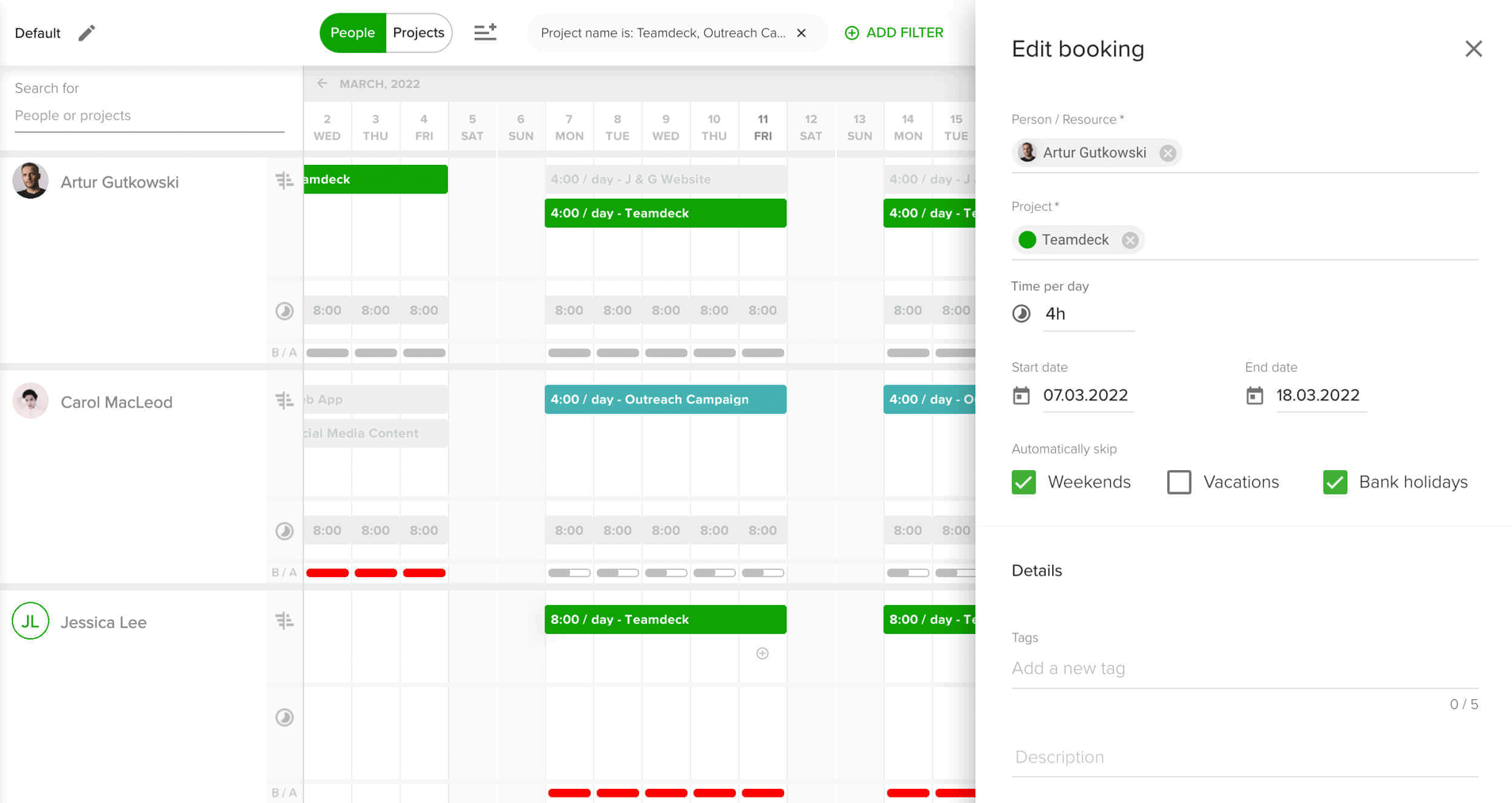
The platform gives managers a clear overview of where people and tasks are at, and it can deliver useful insights into performance with its detailed reporting. These include ROI and productivity insights, and budget and payroll reports.
At a team level, Teamdeck helps people manage their own calendars and workload, track time, and request leave and vacations.
Like other good resource management tools, this app integrates with software such as Asana, Google, and Slack to increase functionality.
Key features
- Team scheduling
- Time tracking
- Workload management
- Project planning
Pricing
Teamdeck only has a two-tier pricing plan:
- Basic Resource ($1 per month, billed monthly)
- Team Member ($3.99 per month, billed monthly)
At a glance, the pricing structure here is… shall we say, a little confusing. So much so that Teamdeck actually provides a flow diagram on their pricing page to help people understand it.
But if you’re only looking for a basic resource management tool that is controlled and accessed by managers, then the $1 per month cost for ‘non-active’ resources is a great deal.
Float – Best resource management tool for distributed teams
Float is a resource management tool that provides robust features for distributed teams. It’s a good fit for studios, agencies, and B2B companies – offering solutions to help you schedule resources and visualize workloads in a unified calendar view.
Project managers can easily search employees and contractors, find who’s available for work, and manage everyone’s workload in real time. Daily notifications and reports can be set up for visibility into tasks and assignments, and there’s a handy iPhone app to keep everyone in the loop if they’re away from their desk.
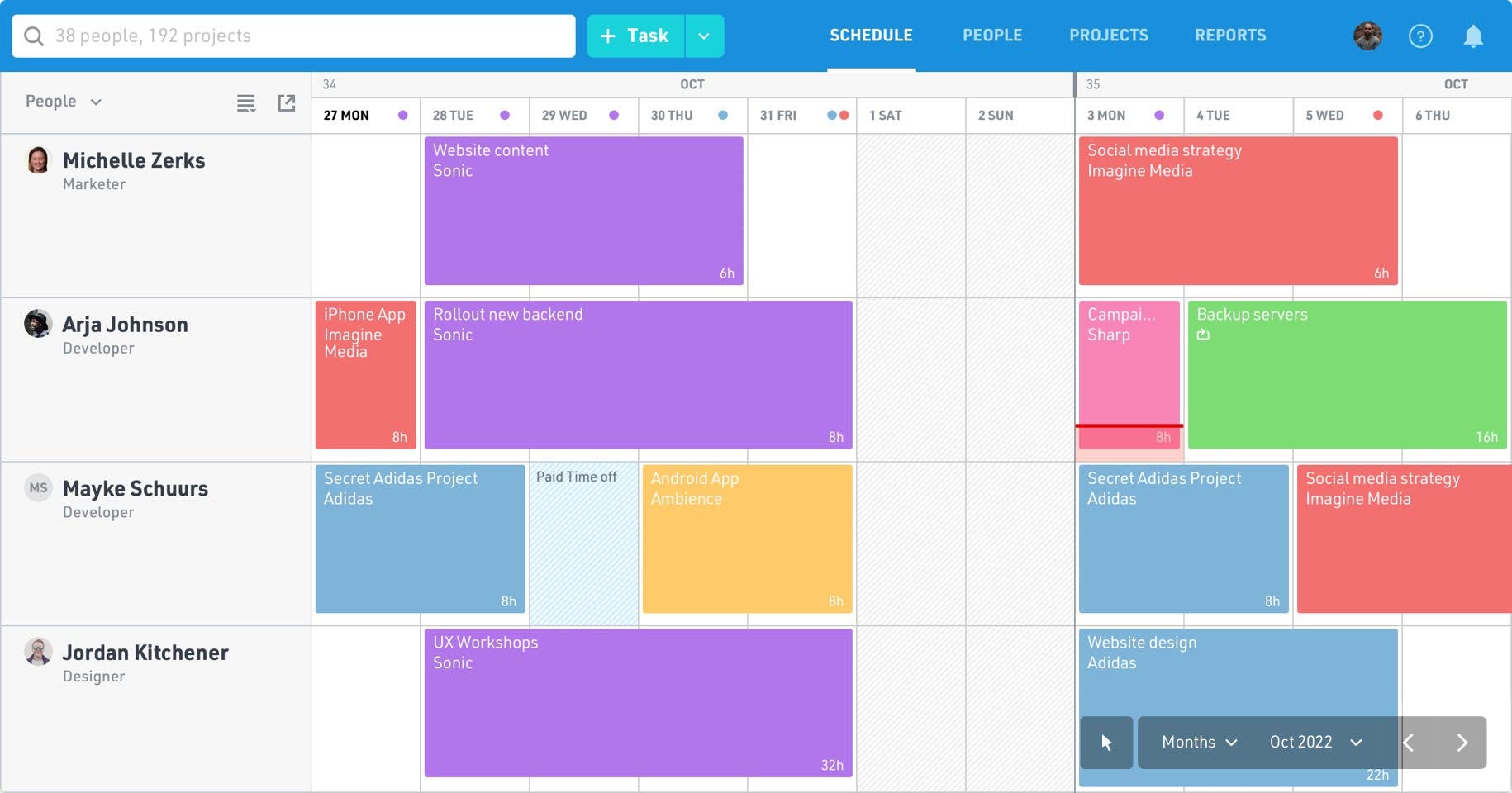
However, Float doesn’t have the same capabilities as a tool like Resource Guru for scheduling and managing non-human resources – which can be an important element for project success. It can also be difficult to tell if there are scheduling issues in Float as there isn’t an active clash management or waiting list feature like Resource Guru has.
Most teams rate Float for its user-friendly, intuitive interface. It’s easy to set up and assign projects, and features a drag-and-drop interface. There’s also a handy menu of dashboard shortcuts that can be accessed with one click to save time. However, not everyone agrees. Some users feel the interface is a “bit clunky” and the navigation is “too complicated”.
In the schedule view, project managers can get a clear overview of who’s available and what their workload capacity is. If a more granular view is needed, the filtering functions can be applied to get deeper insights into schedules. You can set custom hours for team members, highlight public holidays that may impact people’s availability, and schedule leave and vacations.
Float also provides real-time reports on team capacity, budgets, and resource allocation so you can make smarter decisions in your project planning. Integrations include popular project management apps like Asana and Trello, plus Slack and Google calendar to help everyone stay on track.
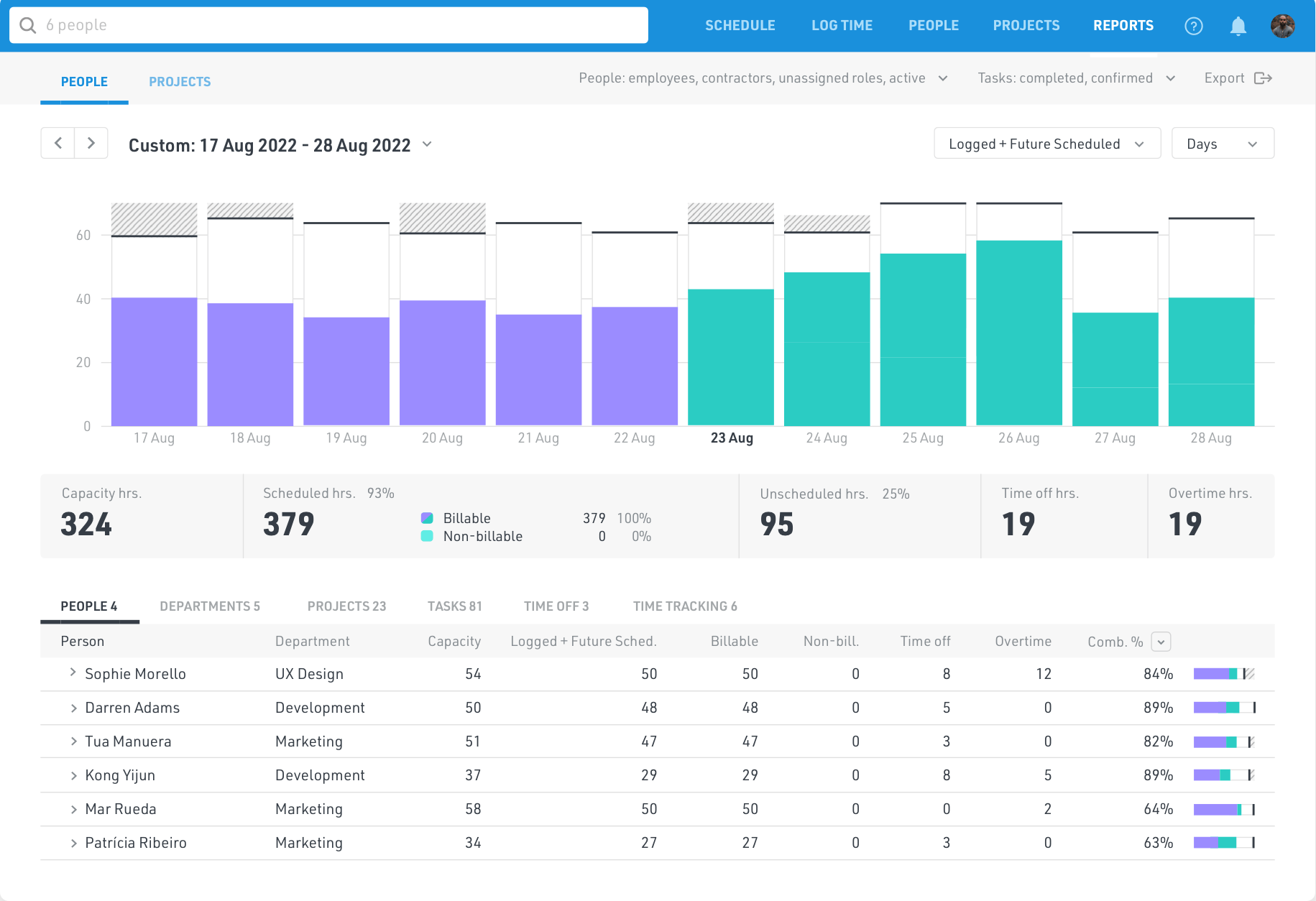
If you’re looking for a resource management tool that has similar features to Teamwork, or if you’re looking for a tool you can use alongside your existing project management software – then Float might be a good fit.
Key features
- Resource scheduling
- Time tracking
- Capacity management
- iPhone app
Pricing
Float has two basic plans:
- Resource planning ($7.50 per user, billed monthly)
- Resource planning and time tracking ($12.50 per user, billed monthly)
The basic plan obviously doesn’t include the time tracking feature, so be aware of that if time management is one of your priorities. The top tier unlocks time tracking, and you’ll also get extra features like the ability to compare estimates and actuals and log hours on the mobile app. Float also offers advanced management controls for an extra $7.50 per person, per month.
While users comment that “it’s low cost to get started” they also acknowledge that “pricing is steep for bigger companies”. Float offers similar functionality to Resource Guru, but will cost you twice as much per person, per month.
Mavenlink (now Kantata) – Best resource management tool for enterprise
Mavenlink (which has recently partnered with Kimble to form the Kantata Industry Cloud for Professional Services™) should be on your list of best resource management tools to check out. As well as offering project management features, it also helps companies plan complex operations, and monitor resource availability.
It’s a solid choice for enterprise teams, as it has a business intelligence feature, plus integrates with the Salesforce CRM, Slack, Oracle, SAP, Quickbooks, Jira, and HubSpot. Mavenlink also offers its own native API integration (M-Bridge) which means you don’t need third-party assistance to integrate with other apps.
This technology platform offers a Godzilla-sized stack of features, housed in a system of modern, minimal dashboards – but as you’d expect, this makes the learning curve a lot steeper than its competitors.
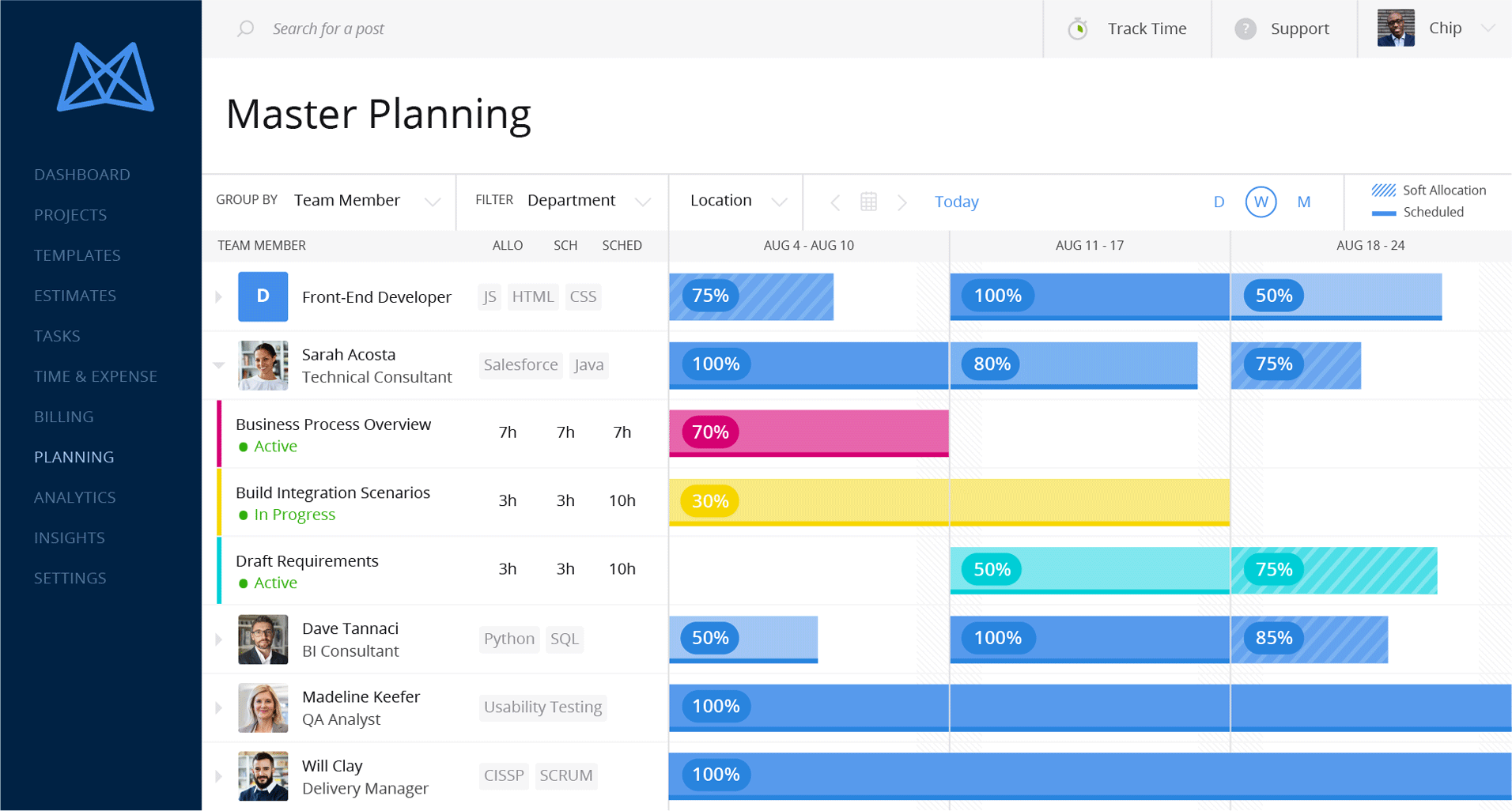
If allocating time and budget for training isn’t an issue, Mavenlink can take care of almost everything required for large-scale project planning – including team collaboration, accounting, in-depth analysis of projects, budgets, margins, performance, and more.
It can help you streamline your processes for skill management, role-based planning, resource forecasting, and capacity management with ease – as well as delivering reports and letting you visualize essential KPIs across projects.
In short, it does a lot. This is fine if you’re going to use all of Mavelink’s features to replace your existing tools – but if you’re only looking for something to improve your resource management capabilities, there are easier and more specialized options like Resource Guru and Float that are designed to handle this much better, and at a much lower cost.
Mavenlink also offers a professional consulting service to help you build out customized reporting for your business and coach your teams on how to get the most out of these resource management tools.
Key features
- Resource management
- Business intelligence
- Workflows
- Capacity management
- Role and scenario based planning
Pricing
There is no transparent pricing page for Mavenlink – making it impossible to glance at their plans and see how much it will cost compared to the other resource management tools we’ve covered here.
To view the prices, you’ll need to navigate through a selection of dropdowns based on your industry, team size, and country – then enter your contact details into a lead capture form to view the price based on the options you’ve selected. Or alternatively, you can just call their sales team.
This gives the plan offerings somewhat of a “cloak and dagger” feel, which might turn you off before you’ve even begun to explore Mavenlink as an option. It also suggests things might be about to get really expensive.
Harvest – Best resource management tool for time and budget-conscious teams
Harvest is best known as a time-tracking software, but it also has other features that help with resource planning and scheduling. It gives organizations visibility into team capacity, budgets, and costs, which enable projects to run smoothly from start to finish.
The built-in reporting gives clear, visual analytics that are easy to understand. This allows teams to compare actual time versus budget, plus timesheet and cost data so you can pinpoint how costs are being affected in relation to tasks, and better estimate future projects.
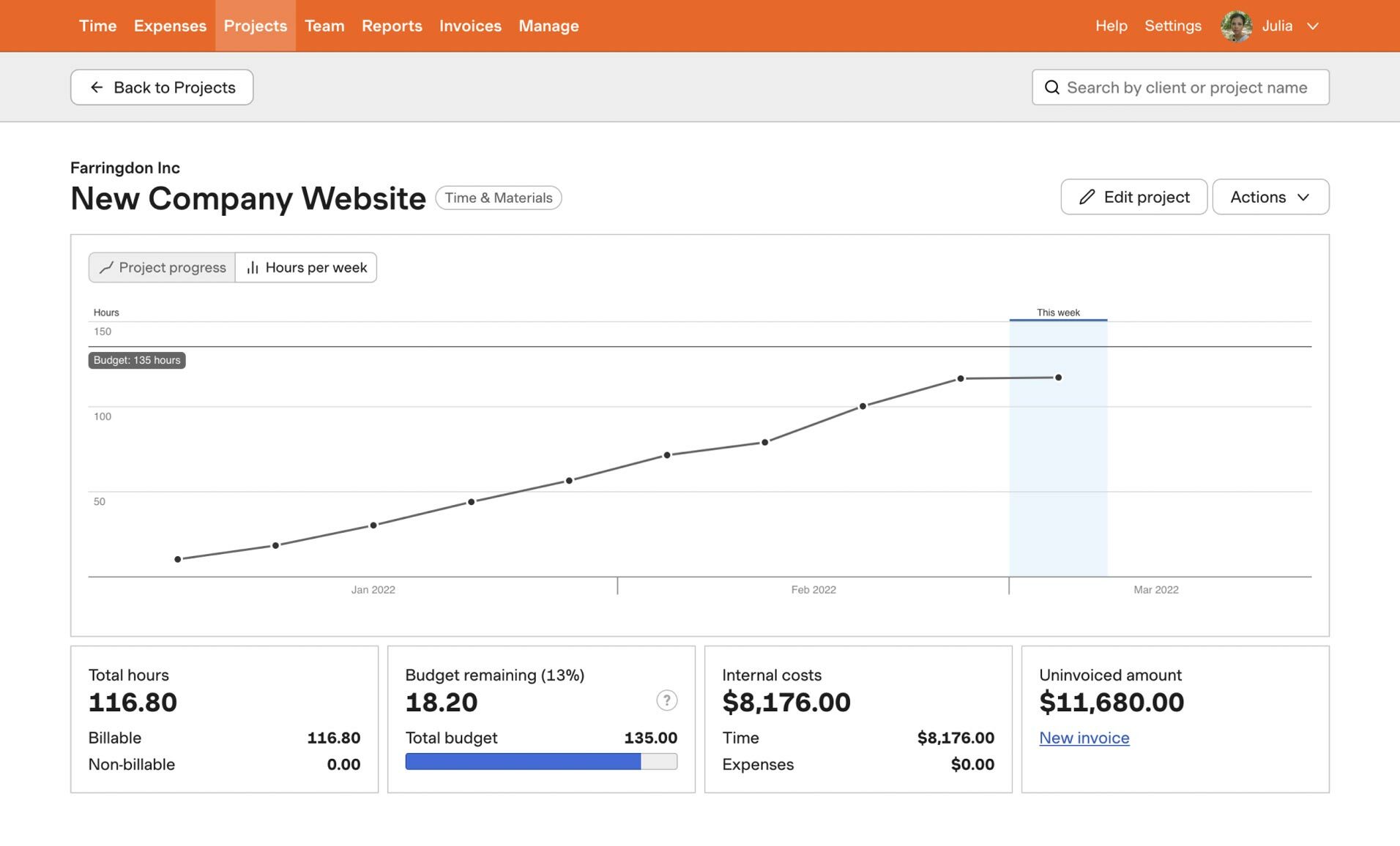
You can use Harvest on any device for maximum productivity, and there’s even an iPhone and Android app to manage things on the move. This platform also integrates with different CRMs and accounting platforms to create a more robust resource management tool.
As we mentioned earlier, Harvest also syncs directly with Forecast. With their combined powers, you’re able to schedule your team members and track their capacity for work. You can also turn your timesheets into detailed reports that give insights into individual team member performance, overtime, billable time, and progress on tasks. But this means paying double the subscription fee to get both feature sets.
Harvest also enables the creation of invoices based on timesheets that can be sent out directly from the dashboard – saving your organization time and reducing your spend on third-party software.
Key features
- iOS and Android app
- Time tracking
- Invoice management
- Reporting
Pricing
There are two straightforward pricing plans:
- Free forever
- Pro ($12 per seat, billed monthly)
Harvest is one of the only resource management tools on our list to offer a free plan. It allows for one user and up to two projects – and generously includes all the features on the Pro plan, like time and expense tracking, mobile apps, invoices, and integrations.
The free plan makes Harvest appealing for small teams, but those teams really do need to be small. With a limit of just one user and two projects, it’s only really suitable for sole operators who are managing small amounts of work at any given time.
Which of these resource management tools is right for your business?
Managing the time and energy of your team members is essential to the success of projects and organizational goals. If you don’t have the right resource management systems in place, poor planning can wreak havoc on your timelines, budgets, and the well-being of your team members.
When you’re looking for a better way to manage resources in your organization, start by thinking about your organization’s primary needs when you’re comparing software options.
For large companies, Mavenlink and Smartsheet are both excellent, if expensive, solutions with plenty of features (though setting them up could require a project team in itself) – while tools like Harvest are better suited for small businesses with a particular need for time tracking.
If you urgently need to get your team’s time management under control so you can plan and schedule resources better, then Teamdeck and Float might be a good fit.
And if you’re dedicated to the productivity and wellbeing of your team members, Resource Guru is laser-focused on resource management, so it has everything you need to make smarter resourcing decisions, balance individual workloads, improve team morale, and help people do their best work.
Try Resource Guru for 30 days and see how better resource management can help you keep your projects on track and your teams happy.




